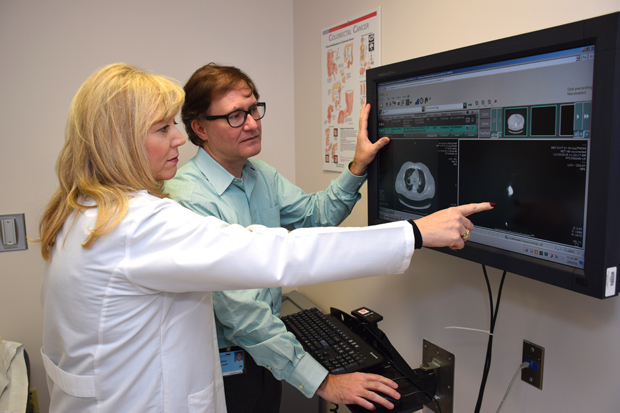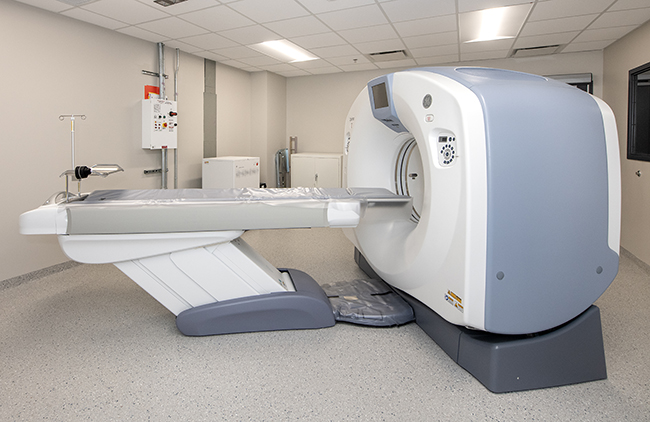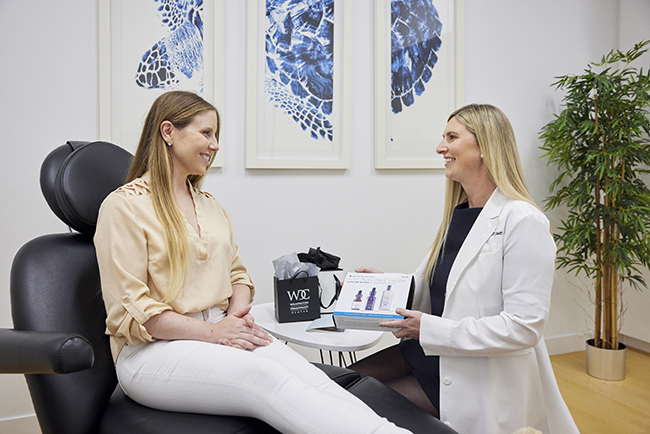The Lung Cancer Arc
27 Aug 2016
Lung cancer continues to win the battle with smokers―Message from Doctors: Quit
By JESSICA SMITH

Of all the most prevalent cancers, lung cancer has the unfortunate distinction of being both difficult to diagnose and hard to cure in the later stages. As a result, lung cancer is the leading cause of cancer death among both men and women in the United States, surpassing the combined totals for colon, breast and prostate cancer patients.
In Wilmington, the patient landscape mirrors the national statistics. A full one-third of the oncology patients treated at New Hanover Regional Medical Center (NHRMC) are diagnosed with lung cancer. Breast cancer patients comprise another third, while the remaining third encompasses all other kinds of cancer.
In 2014, the NHRMC Zimmer Cancer Center treated 366 lung cancer patients. A staggering 72 percent of those patients presented with late-stage lung cancer, with 86 in stage III (in which the disease has spread to nearby or more distant lymph nodes) and 176 in stage IV (in which the disease has spread to both lungs or other organs).
Only 100 patients presented with early-stage lung cancer, and for many of these patients, the tumors were incidentally discovered during other tests – not because the patients (or their physicians) reported any suspicious symptoms. Lung cancer symptoms include chest pain, unexplained weight loss, changes in the voice, and a persistent or worsening cough. By the time those symptoms appear, however, the cancer has likely already spread to other parts of the body.
Fortunately, the FDA recently approved a new screening test that is helping to uncover some of these early-stage lung cancers among the patient population at highest risk of the disease: smokers and former smokers. Physicians perform a low-dose CT scan of the patient’s chest, using a machine that takes three-dimensional X-rays of the lungs while rotating in a spiral motion.
This fast, non-invasive scan does not involve either swallowing a contrast dye or being hooked up to an IV, so it's quite easy on the patient. Most importantly, the new scan has also proven effective at detecting tiny tumors. Whereas traditional X-rays can only identify lung cancers the size of a dime, low-dose spiral CT scans can detect tumors as small as a grain of rice. Early detection of lung cancer is of critical importance in broadening the patient’s treatment options and increasing the chance of survival.
The American Cancer Society has issued physician guidelines recommending the use of this screening for patients who are 55 to 74 years old and in fairly good health, with a 30 pack-year smoking history (as determined by the number of cigarette packs smoked each day, multiplied by the number of years in which the patient smoked). Eligible patients should either have quit smoking within the last 15 years, or still be smokers.
Specialists at the NHRMC Lung Program are excited about the advent of the screening, and hope that more and more patients will enter treatment in the early stages of the disease. Begun in November 2015, the NHRMC Lung Program provides patients with a streamlined, collaborative approach to treatment. Each patient’s records and test results are reviewed by a multidisciplinary care team, who collectively decide the best course of action.
“This program takes the patient from first abnormal scan to the start of treatment as quickly as possible without rushing,” said Dr. Michael A. Papagikos, radiation oncologist at Coastal Carolina Radiation Oncology and member of the program’s multidisciplinary team. “It’s like night and day when compared to a traditional course of treatment, in which it’s common for a patient to wait for weeks in between scans and follow-up testing, and then another few weeks before meeting with the first specialist. Meanwhile, the cancer is growing.”
When a patient’s primary care physician or pulmonologist first suspects lung cancer, they might order a chest scan or biopsy to confirm the cancer’s presence. After the results come in, the newly diagnosed lung cancer patient can be referred to the NHRMC Lung Program’s director and nurse navigator, Lorraine Sieminski, RN, BSN, OCN.
“When Lorraine takes over, she gathers all of the patient’s records together to create a comprehensive story of the patient’s past and current health status,” said Dr. Papagikos. “If the patient needs lab work done or an MRI or PET scan performed, she expedites those appointments and makes sure that we have the results we need before our next session.”
Currently, the clinic meets the first and third Wednesday of the month, but may soon meet weekly due to the steady increase in patient volume. “Since we just opened, we’re in the process of getting the word out that these services exist,” said Dr. Papagikos. “There’s not a lung cancer patient in town who wouldn’t benefit from this fast-track, collaborative model of care.”
During clinic roundtables, the program’s specialists — two cardiothoracic surgeons, two pulmonologists, two medical oncologists and two radiation oncologists — review the patient’s records with the help of pathologists and radiologists. “Instead of playing phone tag with different physicians during the day, we get to sit down together, look at the scans and discuss. This process removes so many barriers and inefficiencies,” said Dr. Papagikos.
Depending upon the patient’s age, pulmonary function, preexisting diseases, and stage and type of lung cancer, the treatment chosen can vary considerably. “We try to be as aggressive as we think is reasonable, while still respecting the patient’s autonomy, desires and risk/benefit threshold,” said Dr. Papagikos. At the end of the session, the team coalesces around a plan.
The patient may then see one to four physicians in quick succession on a single day, as the specialists roll out and explain the course of treatment. Patients are also visited by various members of the program’s support services, such as a nutritionist, smoking cessation specialist or financial counselor. These ancillary services are an important component of the holistic care offered by the program. Visits from the nurse navigator also help to personalize the experience for patients, as she provides a central point of contact and keeps track of the patient’s needs.
Once the plan is in place, treatment proceeds very quickly. Patients are started on a course of radiation and/or chemotherapy, or have surgery to remove the cancer and the surrounding lymph nodes. Sometimes, all three methods are chosen.
Whenever possible, the multidisciplinary team uses minimally invasive techniques designed to decrease the patient’s recovery time, reduce the chance of infection and aid healing. Pulmonologists often make the first full diagnosis, performing a biopsy of tumors from the inside out using a bronchoscope, a flexible device used to see the inside of the airways and lungs.
“A new navigational bronchoscopy procedure combines advanced imaging techniques with electromagnetic navigation. The pulmonologist can navigate down into the smallest bronchi in the patient’s lungs — using technology similar to a car’s global positioning system,” said Dr. Papagikos. “We can access places in the lung’s periphery that were previously inaccessible.”
The thoracic surgeons prefer to practice VATS, or video-assisted thoracic surgery. Instead of opening the patient’s chest, the surgeon accesses the lungs through small incisions, inserting a camera to help guide their instruments throughout the surgery. “This elegant, minimally invasive lung surgery offers our patients a faster recovery time and far less pain,” said Dr. Papagikos.
For patients with stage I cancer who aren’t candidates for surgery, the program’s radiation oncologists also offer a minimally invasive technique. Known as stereotactic body radiation therapy, or SBRT, the treatment uses a specialized map of the tumor’s exact dimensions to focus the delivery of a high-dose radiation treatment directly to the tumor, without affecting the surrounding tissue. “Instead of the standard 35 treatments in conventional radiation therapy, we can now do it in three treatments. It’s not only easier on the patient, but research proves that it’s also twice as effective,” said Dr. Papagikos.
Even patients with stage IV cancer can benefit from more targeted therapies. In recent years, the rapid advances in genetic testing have proven beneficial to lung cancer patients, particularly those with advanced non-small cell lung cancer. “We work to make sure that our biopsies are collecting the right amount of tissue to use in genetic testing, as we know that targeted biological agents work very well for patients with particular genetic mutations,” said Dr. Papagikos.
Certain chemotherapy drugs are also more effective than others against tumors with specific mutations. The program’s specialist can also perform molecular analysis of the patient’s tumor to help determine which therapies would be most beneficial.
NHRMC participates in clinical trials offered by the National Cancer Institute and the pharmaceutical industry. The research team, which consists of dedicated research nurses, routinely reviews the menu of open lung cancer studies, and coordinates patient screening for potential participants. Eventually, the program plans to offer at least one open research study for eligible patients with every stage of cancer.
“We’re not going to change the arc of lung cancer unless we participate in clinical research,” said Dr. Papagikos. “It is my sincere belief that through smoking cessation, early detection, efficient multidisciplinary care, and clinical research participation, we can significantly improve the mortality rates associated with lung cancer in our community.”
Sidebar:
Smoking Cessation: How to Quit Once and for All
Tobacco use continues to be the leading preventable cause of mortality, accounting for more than 450,000 deaths in the United States each year. In this day and age, the deadly effects of nicotine addiction are commonly known. So why are people still smoking?
If you’re a smoker or friends with a smoker, the ups and downs of a quitting attempt are an all-too-familiar story. According to 2016 Gallup poll data, 85% of smokers report trying to quit at least once in their lifetime, and 45% have tried three or more times. And while the majority of former smokers were able to stop smoking with just one or two attempts, 40% had to keep trying until the new habit stuck for good.
In fact, many newly diagnosed lung cancer patients are still smoking, or have only recently quit.
Sometimes, patients feel fatalistic upon their diagnosis, and downplay the importance of quitting. “They believe quitting now won’t make a difference, but that’s a fallacy,” said Dr. Papagikos. “If you quit, your chances of survival are better.”
Tips for Quitting
If you’re a smoker, listen to this. In just one year after quitting smoking, your risk of developing coronary heart disease will drop to less than half of that of a smoker. In five years, your risk of developing diabetes will be equal to the risk for a non-smoker. In ten years, your chances of being diagnosed with lung cancer will drop to between 30% and 50% of the risk for a smoker.
Day after day, the health benefits will keep multiplying. So what are you waiting for? If you’ve tried before but failed, consider that attempt a valuable source of information: now you know what has worked for you in the past, as well as what hasn’t.
Survey your options, make a plan, and try again. This time, you can do it!
Acupuncture: Studies show that a series of four to six acupuncture sessions can decrease a patient’s desire to smoke for up to five years after the initial treatment. Acupuncture sessions are thought to help with cravings and irritability, and to alter the taste of tobacco.
Auriculotherapy: In this one- or two-session treatment, an acupuncturist or other trained provider will stimulate certain acupuncture points on your external ear using a micro-current wand. This procedure does not involve needles, and is thought to help desensitize the neuroreceptors that bind to nicotine to help smokers break their nicotine dependency.
Chantix: This nicotine-free prescription medicine is meant to be taken for three months, and is designed to reduce your nicotine cravings and withdrawal symptoms during your quit. If a smoker slips and starts smoking again, the medicine will also block the effects of nicotine in the body, improving the chances of a permanent quit.
“Cold Turkey”: Also known as an unaided quit, “cold turkey” refers to the practice of abruptly stopping smoking. Three large studies noted that for 75-88% of former smokers, this simple method worked best. If you quit abruptly, make sure to have a proactive plan in place for how you will deal with any new or preexisting stress points. Most importantly, make sure to share the news that you’re quitting, as studies show that having an active support team behind you really does help.
e-Cigarettes, or Vaporizers: These relatively new battery-powered devices heat nicotine (along with propylene glycol, glycerin, and other ingredients) to deliver a dose of nicotine in the form of a cloud of inhaled aerosol. While manufacturers tout their use as a smoking cessation tool, studies show that smokers who used e-cigarettes had a 28% lower chance of quitting permanently than those who didn’t. However, some people are able to gradually taper down the nicotine dosages of the vaporized liquid in order to successfully quit. If you plan on using e-Cigs to help you quit, you must actually stop smoking regular cigarettes for the duration in order to be successful; using both simultaneously does not work.
Nicotine Replacement Therapy (NRT): Essentially, all methods of NRT — including nicotine gum, lozenges, sprays or patches — give the smoker steady, controlled doses of nicotine. As you become more and more comfortable not using tobacco products, you can step down the nicotine dosage dispensed by your chosen method of NRT until you are not using any nicotine whatsoever.
QuitlineNC: Many smokers struggling to permanently eradicate tobacco from their lives may not know about QuitlineNC, a free smoking cessation service for any state resident. A toll-free quit line (1-800-QUIT-NOW) offers advice and support for your quit, while online services offer web coaching and techniques for specialized populations — along with helpful information on how to help others quit smoking.
Smokeless®: Created by the American Institute of Preventive Medicine, this smoking cessation program is designed to help people quit once and for all. NHRMC offers a four-week program with a small class size and dedicated instructor. To register, call Iris Baker at 910.667.8297. A guided self-help program is also available online, offering workbooks, support materials and toll-free counseling.
Sidebar2:
Supporting the Patient Through Caregiver Education
When someone is first diagnosed with cancer, the word usually travels quickly around a community. People leave sympathetic notes on the patient’s Facebook page, or bring over a casserole after church. But what next? How can a patient’s family, struggling to cope with this overwhelming news, get the support they need for the long run?
At the NHRMC Zimmer Cancer Center, the caregiver education class is attempting to answer those questions – along with many more. Conceived as a practical workshop for the caregivers of cancer patients, the class began in the fall. The class meets twice monthly, but most caregivers attend just once, leaving with a large booklet of resources.
Michelle Hoadley, director of oncology and specialty clinics, has been at NHRMC for over 16 years. “A cancer diagnosis affects the whole family, and it’s understandably very stressful. We wanted to wrap our arms around the caregivers as much as possible,” said Hoadley.
The class is run by a varied team of specialists. A dietician teaches participants how to provide patients with the nutrition they need, and gives tips on managing their loved ones’ medication regimens. “Many questions can be very specific to a certain type of cancer,” said Hoadley. “If necessary, we provide resources for a personal consultation, depending upon the caregiver’s needs.”
While the group recognizes that patients need an assortment of support services and therapy, this particular class is not designed for patients. “We want the class to be an utterly safe space for caregivers,” said Hoadley. “They are more open and able to vent or cry if their patient isn’t around.”
Managing stress is always an important topic. The class leaders include a music therapist from the Healing Arts Network, a local group of certified practitioners who use massage, craniosacral therapy and other techniques to help patients reduce pain. “Our musical therapist demonstrates relaxation techniques, such as deep breathing, meditation and desktop labyrinths, to help caregivers reduce their stress,” said Hoadley.
Two social workers help lead the class, teaching caregivers how to manage a schedule of medication and rest, how to track treatments and side effects, and how to build an effective support network around their family.
“There are often people who are willing to help, but the caregivers don’t know how to accept that help. Everybody says ‘call me when you need something,’ but it’s difficult for the caregiver to reach out at the last minute,” said Nicole Hudson, a social worker who has spent six years serving as a patient navigator at NHRMC.
By delegating tasks ahead of time, the caregiver can spread out the support to help sustain the family throughout several months of treatment. “We discuss how to be proactive about seeking the support you need before you need it. Perhaps a neighbor can mow your grass all summer, or your friends can bring over freezable meals,” added Hudson.
The class offers assistance with advance care planning and the execution of documents such as living wills and a healthcare power of attorney. In private sessions, they also offer help with end-of-life care, information about hospice and other practical support.
For those of us who would like to be caring friends to our loved ones battling cancer, Hoadley has one piece of advice to give. “Don’t say ‘call me if you need anything.’ Instead, just say, ‘I’m bringing you a meal next week. Which day should I come?’”













